Electronic Theory
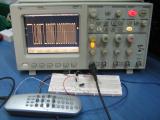 | The Philips RC6 IR Remote Control Protocol
After the RC5 protocol, here is the new and advanced protocol from Philips, the RC6 infrared remote control protocol. Unfortunately, i could not locate not a single official source for this protocol, so everything that you read here comes mainly from reverse-engineering and information gathered around the net.
|
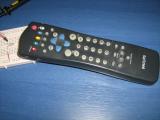 | The Philips RC5 IR Remote Control Protocol
There are a lot (and i mean A LOT) of theory pages around the internet explaining the Philips RC5 protocol, so this page is probably a waste of internet space. Nevertheless, really had to write this page because of two reasons: First, i did not find one page that was able to cover 100% my curiosity, and second, writing a theory page for others is the way that I learn, since i have to learn something in deep details in order to write a good theory page...
|
 | How Phonecard Smart Cards Work
In this theory page i explain how phonecard smart-cards work. Since there are lots of different smart-card types and i cannot cover them all, i explain only the 128-bit Greek telecards from OTE telecommunications. I provide also links to documents which provide info about other phonecards.
|
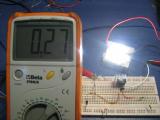 | LED driving and controlling methods
I wrote this tutorial as an intro page for those that do not know how to drive the LEDs and how to control its brightness. The ltimate goal is to introduce the A6210 from Allegro Microsystems, a very efficient LED driver and controller.
|
 | How to check the Windings of a 3-Phase AC motor with an Ohmmeter
A 3-phase AC squirrel cage motor is a very common type used in many applications. In my job, there are machines that have tens of these motors, powered either directly with 3-phase supply or through inverters. It is very important to develop a quick and reliable methodology to check if the motor coils have a problem or not.
|
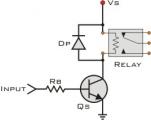 | Basic Transistor Circuits
This is my most viewed - most popular theory page. In this article i present a bath of useful circuits made with transistors, such as relay drivers, light/dark detectors, oscillators, flip-flop circuits, switch debouncers etc.
|
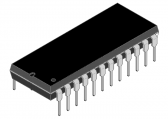 | Semiconductor Package Families
The electronic components come in standard packages. In this page I have links to PDF files with the dimensional drawing of these packages
|
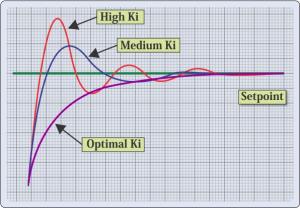 | PID Theory
I plan to make a PID controller so i had to study about PID in general. In this page i explain what the terms P, I and D means and why this system is so widely used in modern automation
|
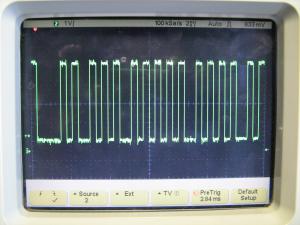 | Pulse Position Modulation and Differential PPM
Pulse Position Modulation is one of the most efficient data coding systems thanks to its high level of modulation compression, but not very reliable though. It s not used in critical systems or cable data transmissions, but it is widely used in remote controls and optic fibers.
|
 | Manchester and Differential Manchester Code
I plan to make some circuits with remote infrared communication. After some research, i discovered that one of the most common coding methods for IR communication is the Manchester Code. I studied this method and -as usual- i wrote a theory page to use it as a reference.
|
 | The Charlieplexing
Charlieplexing is a rather new LED multiplexing technique, that utilizes the tri-state function of microcontroller's I/O ports to control more efficiently LEDs.
|
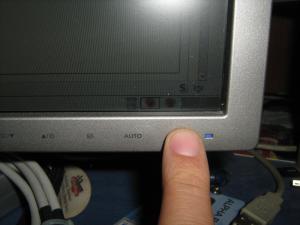 | How Touch Buttons work
In this theory page, i explain how the touch switches (buttons) work. I cover various methods, the resistance touch sensor, the AC Hum touch sensor and the capacitance touch sensor. I extensively cover the capacitance touch sensors. Also, i explain how a capacitance touch sensor can be used to make buttons that are covered under non-conductive materials, such as plastic, wood, plexiglas etc.
|
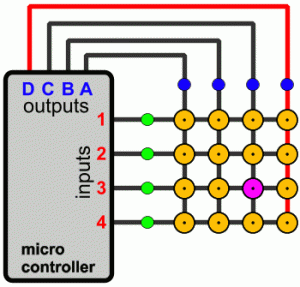 | How a Key Matrix Work
In this article i explain how the key matrices works. A key matrix is a technique to interface multiple buttons into a microcontroller, using as less ports as possible. Such a technique is used in your PC keyboard to interface all 101 (or more) keys using around 26 ports. Also i explain what the ghosting and masking problem is and how to deal with it.
|
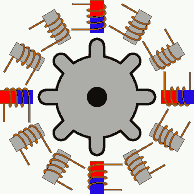 | How Stepper Motors Work
Using animations and with a long 3D modeling video, i explain how the stepper motors work. You will learn what types of steppers exist, how they can be controlled and also how the coils are internally connected.
|
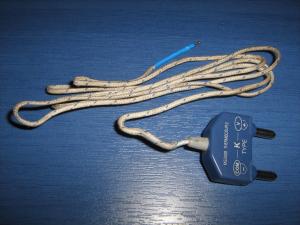 | How Thermocouples (TCs) Work
Thermocouples are wire pairs that have the characteristic of producing a slight voltage according to their junction temperature. They are widely used in automation and industrial applications. In this article you will learn how they work and how you can acquire the measurement. Moreover, you will learn how to convert the voltage reading into the actual junction temperature.
|
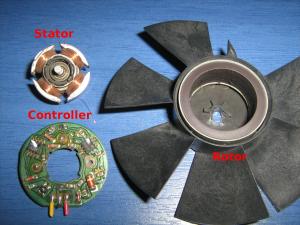 | How PC Fans Work
Most probably there is more than one fan inside your PC. In this article i explain how the classic PC fans work, the different types of PC fans (2, 3 and 4 wires) and how they are internally wired.
|
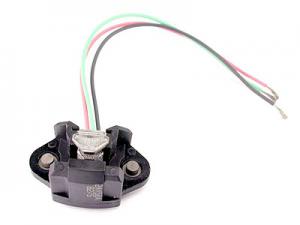 | The Hall Sensor
The Hall sensor is a small electronic component that can sense a magnetic field, and also it can distinguish the North and South pole. Read tis article to read the history of the Hall sensor and how it works.
|
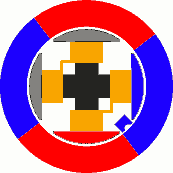 | How Brushless Motors Work (BLDC Motors)
The brushless motors (BLDC) are widely used due to their accuracy and reliability. Read this article to learn how the BLDCs operate. A long 3D modeling video and many animations will help you learn the BLDCs easily.
|
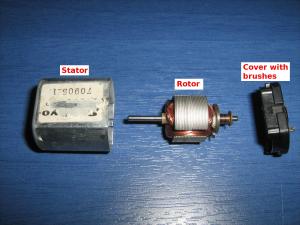 | How DC Motors are made and how they work
If you mess with electronics, it is almost impossible that you have not came across a DC motor. Most probably you have chopped one at least once to see how it works. In this article, i use sophisticated animations and a long 3D modeling video, to explain how the DC motors are made and how they work.
|
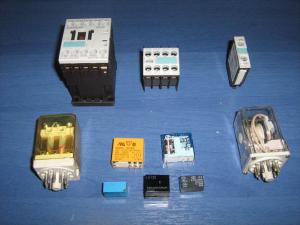 | How Relays Work
Many people do not know how the relays are made and how they work. Many people do not know the different types of relays that exist. Read this article to learn which types of relays exist and how they operate. It is most likely that you will learn about a relay type that you did not know...
|
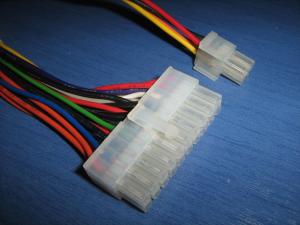 | PC Power Connectors
You all know these Molex connectors don't you? Did you know that Molex is the name of the company that first made this connectors? Do you know how many different PC Power connectors exist? Do you want to know what each pin does? Read this article.
|
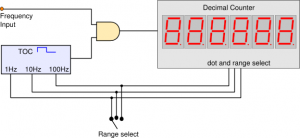 | Frequency Measuring
Frequency measuring is required in numerous applications, from motor RPM speed measuring to sensor value acquisition and more. There are some point that you need to be aware of, and also there are 2 basic methods to measure the frequency according to the speed.
|
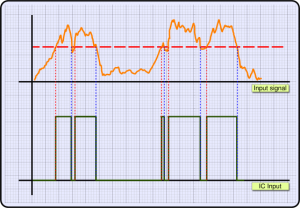 | The Schmitt Trigger
The Schmitt Trigger is used basically to provide rectangular pulses out of an irregular waveform, but it is also used for other applications, for example to generate a hysteresis circuitry. In this theory page i explain in details how it works and i present the most basic circuits to implement a Schmitt Trigger, with single and dual power supply, inverting and non-inverting output, using OP-Amps and simple transistors.
|
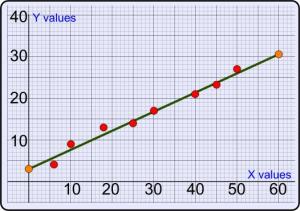 | The Least Squares Fitting
I use the least squares fitting method in almost any experiment that i make and provides a linear equation. This mathematical method will get any number of X-Y pairs and according to these pair, it will generate the best line that can be drawn to go through all these point, as close as possible. I also provide an on-line calculator to make your calculations immediately, and also an on-line calculator to calculate the line for you.
|
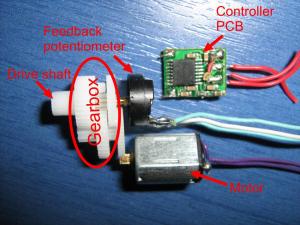 | How RC Servos Works
You do know RC Servos don't you? Do you know how they work/ What signal they use? How to control them? I chopped an RC servo for you and i explain how it works, and also i provide a table with the most common servo wire color code. Finally, i present a very simple circuit to control an RC servo using a potentiometer and a 555 timer.
|
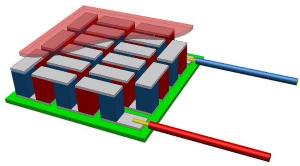 | The Peltier Thermo-Element
You have probably hear about Peltier Thermo-Elements (or TEs), but do you know how it works? How is it made? I also explain in details how to control one and how to calculate the efficiency and the operating parameters. Do not start a TE project without having this article read...
|
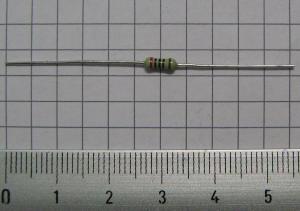 | The Resistor
The resistor is a fundamental part used in all electronic circuits. It is essential to know the ohm law and how to read the resistor value from the color code.
|
 | The Triac
Connecting 2 SCRs together will make you a TRIAC. The TRIAC is a widely used switching component. It is used in dimmers, relay and power drivers, inverters and more. Learn how it is made and how it works.
|
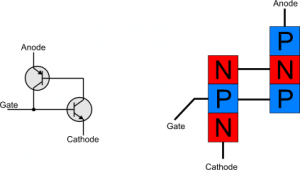 | The SCR
The SCR is used mainly to control AC loads. It is an essential component for power electronics. Learn the history of the SCR, how it is made and how it works.
|
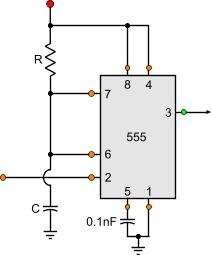 | 555 Circuits
The top-seller IC with the most applications. In this article i present some of the most common 555 circuits, such as the monostable and astable multivibrator, light detector, power missing detector, pulse missing detector, touch switch and lots more. Check it out!
|
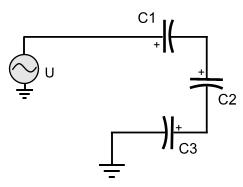 | Connecting Capacitors
What happens if multiple capacitors are connected together? How is tie total capacitance calculated?
|
 | The Capacitor
Read this article to learn what is a capacitor, how it is made, how it works, which types of capacitors exist and the basic uses of the capacitor.
|
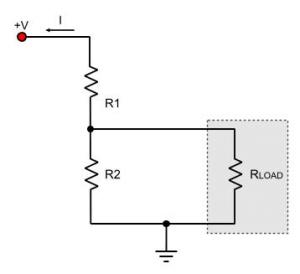 | The Voltage Divider
A voltage divider is an electronic circuit mainly composed by two or more resistors. It is used to provide specific voltage to other components such as transistors. Read how it works and how you can make your own voltage divider. Also, i provide an on-line calculator to calculate the resistor values yourself with ease.
|
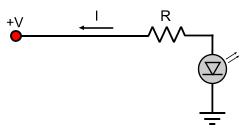 | Ohm's Law
The fundamental law of electronics...
|
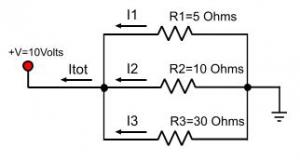 | Connecting Resistors
Read what happens if multiple resistors are connected together in series or parallel, and how you can calculate the total resistance. Find an on-line calculator to help you in your calculations.
|
 | Reading Part Values
Electronic parts such as resistors and capacitors, have usually their value printed with a color code or with number codes. Read this article to learn how you can read these codes. Find also on-line calculators to get the values at once.
|
 | LEDs
LEDs is the revolution in light. Yet, it was discovered by accident and the discovery was kept deep in a drawer for many years. Learn the history of LEDs, how they are made, how they work and how to light them without burning them! Find also an on-line calculator to calculate the protective resistor needed for you.
|
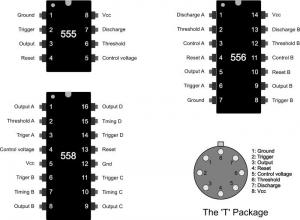 | 555 Theory
Learn how the most popular timer chip in the world works, in very simple steps. Learn what you can do with this chip. Find also an on-line calculator to help you in your calculations.
|
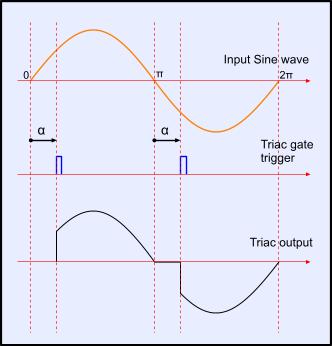 | Dimmer Theory
What is a dimmer and how it works? Read this detailed article that explains the dimmer theory of operation. For more advanced readers, i have include a zero-cross detection circuit to use with your own homemade dimmers
|
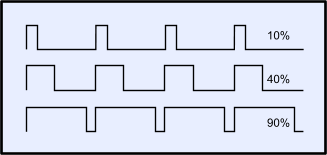 | PWM Modulation
The Pulse Width Modulation is a widely used technique in signal transfer, power control and other applications. In this article i explain some used of the PWM signal.
|
 | The PS2 protocol
I am sure you do remember the PS2 keyboards. Many of you still have one in front, although the USB is winning the race day by day. Yet, motherboards still have the PS2 port on-board. Here is the complete theory for the PS2 protocol, in case you just want to learn how it works, or you want to make a circuit that communicates with this port.
|
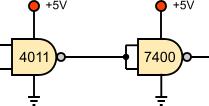 | Interfacing ICs
Over the years, different IC families have been made, like the CMOS and the TTL families. Learn how you can interface IC of the same of different families, under the same or different voltage.
|
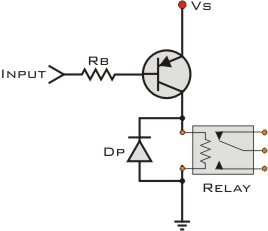 | Basic Transistor Circuits
This is my most viewed - most popular theory page. In this article i present a bath of useful circuits made with transistors, such as relay drivers, light/dark detectors, oscillators, flip-flop circuits, switch debouncers etc.
|
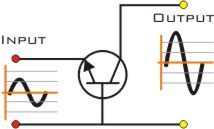 | BJT Transistor theory
Here you will find the detailed basic theory of the transistor operation. If you are a beginner, then this page will surely help you to understand this revolutionary component
|
|

 Home
Home
 Projects
Projects
 Experiments
Experiments
 Circuits
Circuits
 Theory
Theory
 BLOG
BLOG
 PIC Tutorials
PIC Tutorials
 Time for Science
Time for Science
 Contact
Contact
 Forum
Forum
 Projects
Projects
 Experiments
Experiments
 Circuits
Circuits
 Theory
Theory
 BLOG
BLOG
 PIC Tutorials
PIC Tutorials
 Time for Science
Time for Science
 RSS
RSS